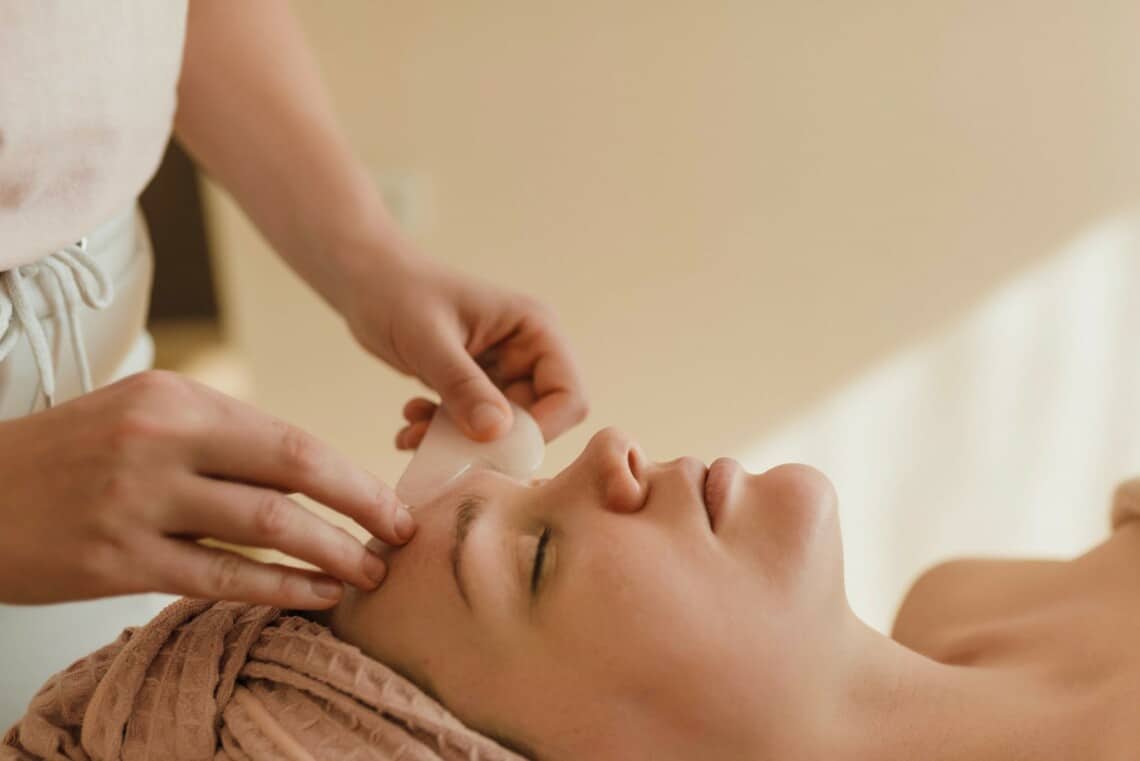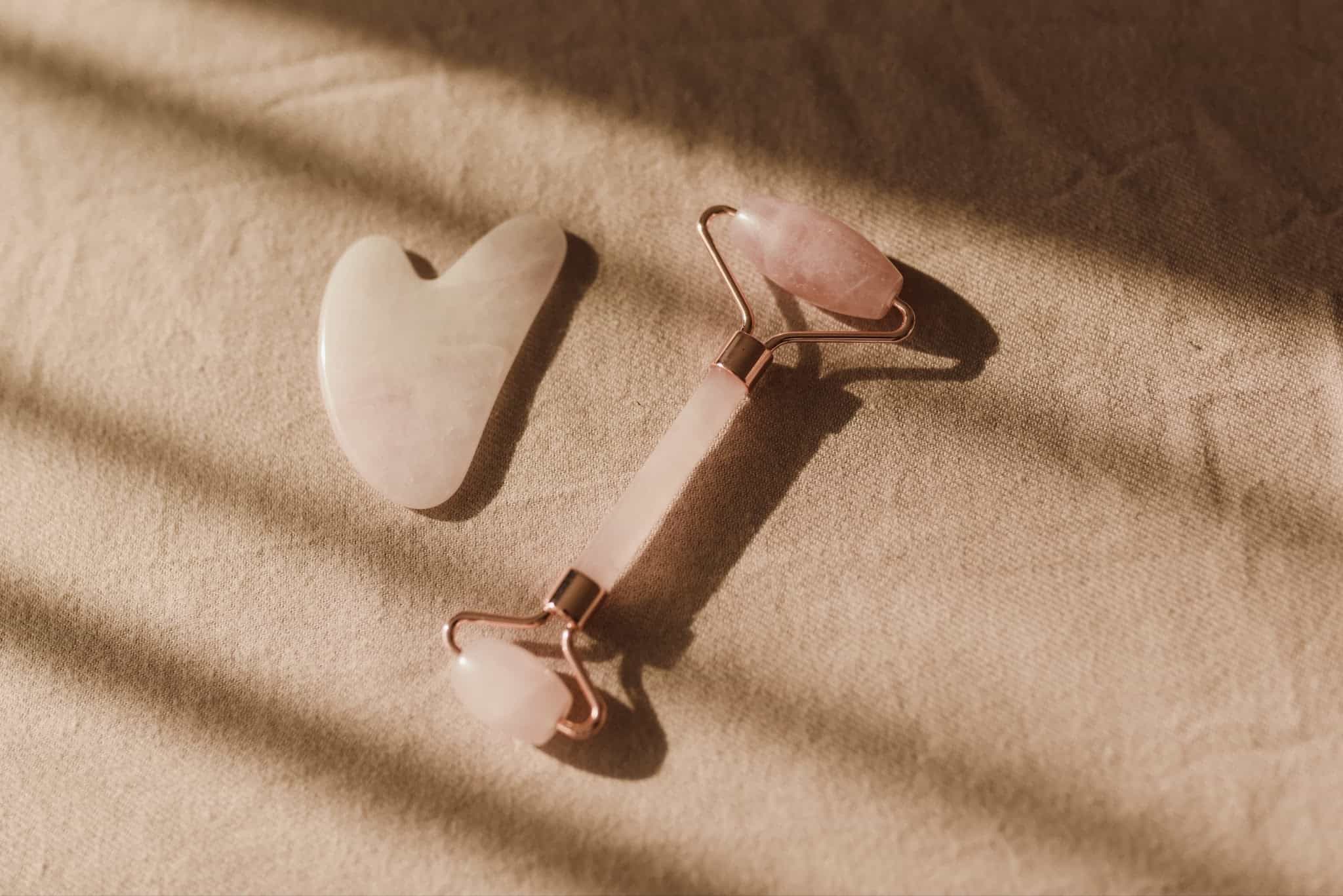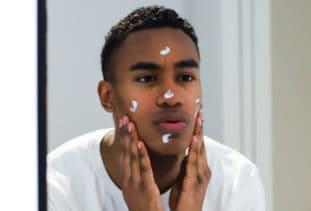Even if you’re not a fierce follower of skincare trends, you’ve probably caught on to the hype behind the jade roller and Gua Sha facial tool.
Both the jade face roller and Gua Sha stone are used to pamper your face by way of lymphatic massage, but they serve different purposes, which is why they look different. Jade stone rollers have a smooth, rounded stone or crystal roller attached to a handle, while a Gua Sha stone is a flat, smooth skincare tool that fits in the palm of your hand.
In this skincare guide, we’ll cover everything you need to know about the jade roller vs. Gua Sha so you can equip your arsenal of skincare products with the very best.
Origin Story: Gua Sha vs. Jade Roller
While both tools have origins in traditional Asian medicine, their histories point to some key differences in how they’re used.
Gua Sha
Originating in East Asian cultures and medicine, traditional Gua Sha practices involved the use of a smooth, flat skincare tool to press and scrape the surface of the skin. The goal of this technique was to promote healing and relieve pain and tension throughout the body.
After spreading through Asian immigrant communities, the medical discipline of Gua Sha rose in popularity in the West, where it is commonly used to practice facial massages. However, some beauty professionals still offer traditional Gua Sha for the entire body.
Jade Roller
Like Gua Sha stones, jade rollers have historical ties to East Asian and Chinese medicine. Jade rollers were actually treasured by Chinese royalty as far back as the Qing dynasty, beginning in 1644.
Unlike Gua Sha tools, however, jade stone rollers were not a method to relieve pain, but rather used as an effort to balance the body’s energy, or chi, by drawing out negative energy. They were also believed to have anti-inflammatory benefits that kept the skin looking bright and youthful.
Looking for ways for how to depuff your face? Today, most jade rollers are sold for the purpose of “de-puffing” the face, reducing inflammation, or aiding lymphatic drainage.

How They’re Made
It’s true that both these facial tools have made stunning appearances in social feeds, where they’re often pictured in mesmerizing shades of polished pastel green and pink.
But what are these skin tools really made of? Let’s dive in.
Gua Sha
Historically, Gua Sha tools were made with a variety of concave materials, including:
- Spoons
- Crystals
- Stones
- Coins
Today, most Gua Sha tools available for purchase come in the form of smooth, flat crystals or kidney-shaped stones that fit in the palm of your hand. But their shapes can vary, and they sometimes feature different indentations to aid different parts of the face when massaging. You will find most estheticians that specialize in lymphatic drainage massage will use a variety of Gua Sha tools to sculpt different facial zones.
Jade Roller
In contrast to Gua Sha tools, the shape of jade rollers seems to have stayed consistent. A face roller at the Metropolitan Museum of Art that dates back to the 18th century displays many of the same characteristics of the rollers we know today, including:
- A smooth, rounded handle
- A metal loop at one end that holds one or more “rollers”
- Rounded rolling stones, usually made of some form of crystal
Some jade rollers available today have a roller on only one end, while others have rollers at both ends, often with two different sizes.
What About the Crystals?
Crystals are the primary material found in many Gua Sha stones and jade rollers. However, you can also find facial tools made from rose quartz, amethyst, and tourmaline.
Although many traditional and spiritual beliefs are tied to the various qualities of different crystals, there isn’t much research on whether different crystals actually produce different results when massaging your face.
However, materials like jade and rose quartz are often touted for their mystical and sometimes medicinal properties:
- Jade – A naturally cooling crystal, jade is said to aid in calming your skin and is traditionally associated with longevity and prosperity. Because it is said to have balancing properties, jade may be beneficial for those looking to lift, clarify, or contour their skin.
- Rose quartz – Sometimes known as the “love stone,” this crystal is said to open the heart chakra, which is associated with healing. For this reason, you may want to choose a rose quartz Gua Sha tool or roller if you have sensitive skin or other reactive skin conditions.
What They Do for Your Skin
Although Gua Sha tools and jade rollers are both skin-massaging super gadgets, the science behind them suggests that they can each benefit your skin differently. Let’s take a look.
Gua Sha

According to studies, the pressing-and-scraping technique of Gua Sha is shown to have several benefits, including:
- Increased circulation
- Pain relief
- Reduced tension
Jade Roller
Meanwhile, research has found several benefits related to facial massage with rollers, including:
- Increased circulation
- Fewer visible wrinkles
- Firmer skin
Facial massages with both jade rollers and Gua Sha tools are also said to help with lymphatic drainage. While the jury is still out on the benefits of this, many of those who use these tools seem to favor them equally for their ability to help reduce facial bloating and puffiness.
Which One Is Right for You?
Still not sure whether you should go with a jade roller or pick up some Gua Sha tools for your facial massage needs? Here’s what our comparison of Gua Sha vs. roller suggests you choose based on your skincare goals:
- Gua Sha – Add a Gua Sha stone to your nightly routine if you want to relieve facial tension, alleviate muscle pain, and increase circulation after a long day.
- Jade roller – Glide a jade roller over your skin if you’re looking to reduce the appearance of wrinkles and firm up your skin.
- Both – Together, a Gua Sha tool and jade roller are your facial go-tos. They can brighten your complexion and reduce any facial bloating or puffiness you may experience in the early-morning or late-night hours.
How to Use Them
We’ve covered the essentials of jade roller vs. Gua Sha, but how are these tools used? While there are plenty of diagrams and tutorials out there, we’ve broken down the facial massage techniques for each of these tools into a few easy steps.

Jade Roller
A facial massage with a jade roller is relatively easy to do, even with little or no experience.
- First, cleanse your face and remove any products or makeup.
- Next, apply a lotion or oil to your skin to help lubricate the rolling process.
- With gentle but firm pressure, use the roller in an upward motion starting from your neck, jaw, cheekbones, temples, and then forehead.
- When you’re done, wash your face again to remove any excess oils or lotion, then complete the rest of your skincare routine.
Gua Sha
Wondering how to use a Gua Sha? Compared to using a jade roller, the use of Gua Sha tools for a facial massage can seem a little more complicated at first. Once you start, however, it’s easy to get the hang of it.
- Wash your face and remove any products or makeup.
- Just like with a jade roller, you’ll want to apply a facial oil or lotion to help lubricate the massage.
- With firm but gentle pressure, pull your Gua Sha tool upwards from your neck to your jawline, repeating until you’ve gone from one side to the other.
- Starting from your chin, pull the tool up along your jawline and toward your ear. Repeat toward the other ear.
- Glide your tool outward from the center of your cheeks and forehead, repeating in each direction.
- With very gentle pressure, pull the tool from the inner corner below each eye and out toward your temple.
- Starting from the inside corner of each eyebrow, glide the tool outward and upward.
- Just like with a jade roller, you’ll want to finish by washing off any excess oils or lotion and then complete the rest of your skincare regime.
Tips and Tricks
To ensure the best results when using either Gua Sha or a jade roller, you’ll want to:
- Make sure to clean your facial massage tools after each use to avoid spreading bacteria.
- Not skip the use of oils or lotion to lubricate your skin before starting. This step helps to prevent skin damage and irritation.
- Check that the crystals are real when shopping for either of these tools. Though many are available at very affordable prices, you’ll want to verify their materials to ensure they’re genuine and that you’re getting what you paid for.
Get the Results You Want with StyleSeat
From de-puffing the face and reducing inflammation to achieving firmer skin and better circulation, both of these facial massage techniques are sure to provide benefits—in addition to the luxurious and relaxing experience of massaging your face with a beautifully crafted Gua Sha tool or roller.
If you’re ready to get started, one of the best ways to learn is to see a professional at work. Whether you are searching for a qualified facialist in Houston or a reputable esthetician in Atlanta, with StyleSeat, you can search our directory of skincare experts to book a facial massage today.
Sources:
PubMed. Effectiveness of traditional Chinese “Gua Sha” therapy in patients with chronic neck pain: a randomized controlled trial. https://pubmed.ncbi.nlm.nih.gov/21276190/
South China Morning Post. Jade rollers: how the West fell for TCM-inspired facial beauty tool that’s old hat to many in China. https://www.scmp.com/lifestyle/fashion-beauty/article/2164492/jade-rollers-how-west-fell-tcm-inspired-facial-beauty-tool?module=perpetual_scroll_0&pgtype=article&campaign=2164492
Metropolitan Museum of Art. Massage roll. https://www.metmuseum.org/art/collection/search/43291
Fashion Magazine. A Guide to The Different Materials of Gua Sha Stones. https://fashionmagazine.com/beauty-grooming/gua-sha-stones-materials/
Gemological Institute of America. Rose Quartz History and Lore. https://www.gia.edu/rose-quartz-history-lore
ScienceDirect. The Effect of Gua Sha Treatment on the Microcirculation of Surface Tissue: A Pilot Study in Healthy Subjects.https://www.sciencedirect.com/science/article/abs/pii/S1550830707001772?via%3Dihub






